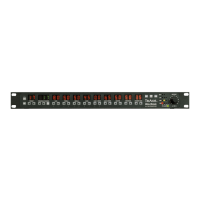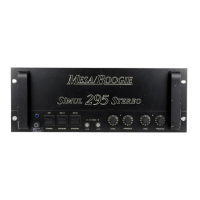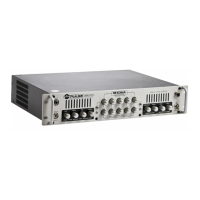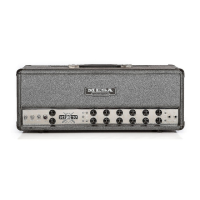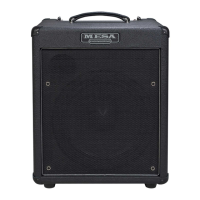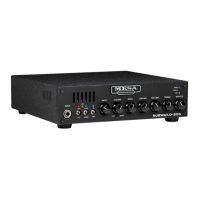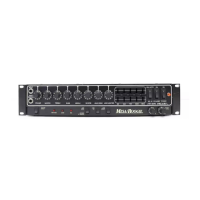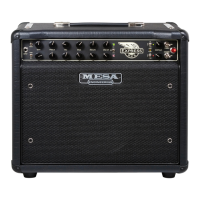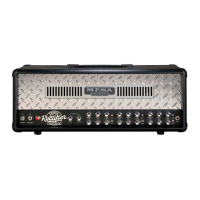HELPFUL HINTS
NOTE: REDUNDANT INFORMATION: Throughout this Operating Guide you will encounter redundant information and sections that
are repeated for your continued awareness and as reminders. This is done so a person can read only the sections they are interested
in, and yet still get the important points they should know or NEED to know about the TRIPLE CROWN. We apologize if this gets
annoying for the cover-to-cover reader, but even they may appreciate it some time in the future when referencing this Guide quickly
for a specific topic.
• Beware of high settings on the BASS control in Channels 2 and 3, especially when the GAIN is set high. Too much BASS will pro-
duce a flubby, indistinct attack and “slow” the response time. A basic rule regarding the BASS control might be this; As the GAIN
goes up...the BASS should come down.
• The GAIN and TREBLE Controls are the most powerful tone shaping controls in each Channel and should be used with taste.
They determine much about the attack characteristic and the overall personality of the sound in all the Channels. Many of the great
sounds in all the Channels will find these two Controls in their middle ranges.
NOTE: Avoid setting the TREBLE high (above 2:00) when the GAIN is to be set high as this brings about the tendency for a slightly
microphonic tube to ring or squeal.
• Your TRIPLE CROWN will sound better and feel better to play if you have at least one speaker cabinet touching the floor you are
standing on while you play. The coupling effect and especially the transmission of bass frequencies will cause the amp to sound
fatter and the strings to feel more substantial and tangible when the amp (or cab) sits on the floor. Wood floors (like stages) are
really great! Let’s face it... the guitar can be one of those weird instruments that rarely feels the same way two days in a row, night
to night, from room to room... and we can use all the help we can get. This usually helps... with the only exception being a stage
filled with too many live mics...sometimes then you are forced to lift the amp to avoid the coupling effect.
• Use the STANDBY switch every time you power-up (from cold or hot), during set breaks, cable hook-ups and anytime you are not
playing for a few minutes. Doing so will increase the toneful life of your tubes.
• Be sure to check the SPKR ON/OFF switch if you get no signal (Live using Cabinets or the internal Combo speaker) when all other
Controls and Switches are at settings that should produce sound. It is common for this switch to be accidentally turned off during
setup or connecting speaker cabinets, or even when programming MIDI information. This is especially true when demo-ing the
amplifier in music stores where the previous party to audition the amplifier may have switched it on and off.
• Circuits emanating from this “other side” of the MESA Line and sharing that DNA tend to favor TREBLE and PRESENCE control
settings on the lower side for sounds in the warmer domain. Depending on guitar woods, pickups and technique, don’t be surprised
if you find great sounds below 12:00, or even all the way off on the TREBLE and PRESENCE, with the MID’s broad Q that carries
substantial top end providing all the top end cut you need.
FRONT PANEL
GAIN
This is, by far, the most powerful control in the TC-50 and its setting determines the style and personality of the Channels.
It meters the gain in different tube stages depending on the Channel called up – and it sets Input Stage headroom - which determines
whether the sound will be clean or overdriven. It also acts as a subtle Tone control as the tube stages’ gain is increased and decreased
and imparts its own “color” on the sound.
In all the Channels, there are three regions of the GAIN control – a low gain zone between 8:00 - 11:30, a warmer, more saturated
zone from 11:00 - 2:00 and a higher gain zone from 2:30 – 5:00. Each of these zones can be used for many different applications
and all can be used for both chording and single note solo work. As the GAIN control is swept throughout its range it imparts differ-
ent textures and tonal characteristics.
Generally speaking, the lower end of the control (8:30 – 11:30) in both Channels and Modes produces a brighter, more open char-
PAGE 5
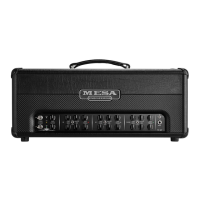
